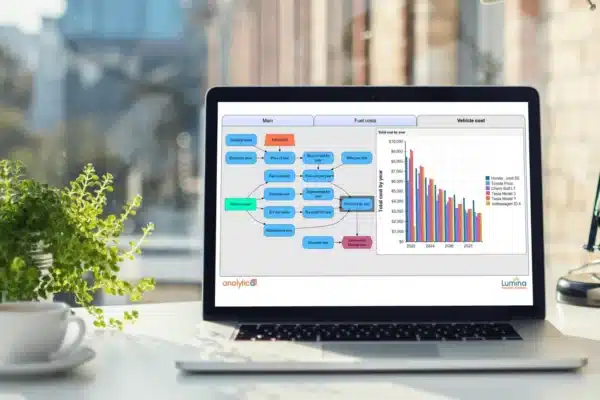
Publications using Analytica
Hundreds of journal articles and other publications are based on research using Analytica. See below for a list of selected publications from a variety of fields:
Email us at [email protected] to suggest your own or other articles for inclusion.
About Analytica
Max Henrion, “Why most big data analytics projects fail” (2019). ORMS Today, Analytics Projects.
Jorge E. Muro Arbulú, “Toma de decisiones bajo incertidumbre: Enfoque estadístico. Uso de simulaciones para la mejora de las decisiones” (2019). ISBN 978-612-00-4440-7. pp 594. (Title translation: Decision making under uncertainty: A statistical approach. Use of simulations to improve decisions.) See our review.
M.G. Morgan and M. Henrion, Uncertainty: A Guide to Dealing with Uncertainty in Quantitative Risk and Policy Analysis, 2nd edition, Cambridge UP, New York, (1990). See chapter 10: Analytica: A Software Tool for Uncertainty Analysis and Model Communication.


Ecology
Mark E. Borsuk, Peter Reichert, Armin Peter, Eva Schager and Patricia Burkhardt-Holm (2006). Assessing the decline of brown trout (Salmo trutta) in Swiss rivers using a Bayesian probability network, Ecological Modelling 192(1-2):224-244.
Rebecca Montville and Donald Schaffner (2005). Monte Carlo Simulation of Pathogen Behavior during the Sprout Production Process, Applied and Environmental Microbiology 71(2):746-753.
Mark E. Borsuk, Craig A. Stow1 and Kenneth H. Reckhow (2004). A Bayesian network of eutrophication models for synthesis, prediction, and uncertainty analysis, Ecological Modelling 173(2-3):219-239.
Mark E. Borsuk, Sean P. Powers, and Charles H. Peterson (2002). A survival model of the effects of bottom-water hypoxia on the population density of an estuarine clam (Macoma balthica), Canadian Journal of Fisheries and Aquatic Sciences (59):1266-1274.
S. K. J. Rasmussen, T. Ross, J. Olley and T. McMeekin (2002). A process risk model for the shelf life of Atlantic salmon fillets, International Journal of Food Microbiology 73(1):47-60.
Energy
Satchwell, A., Carvallo, J.P., Cappers, P., Milford, J., and Eshraghi, H. (2023). Quantifying the Financial Impacts of Electric Vehicles on Utility Ratepayers and Shareholders. Berkeley Lab (LBNL) Publications and Reports
Sherwin, E. (2021). Electrofuel Synthesis from Variable Renewable Electricity: An Optimization-Based Techno-Economic Analysis. Environmental Science Technology
Rath, M., and Morgan, M.G. (2020). Assessment of a hybrid system that uses small modular reactors (SMRs) to back up intermittent renewables and desalinate water. Progress in Nuclear Energy, 122.
Li, F. G. N. and N. Strachan (2019). Take me to your leader: Using socio-technical energy transitions (STET) modeling to explore the role of actors in decarbonization pathways. Energy Research & Social Science 51: 67-81.
Evan D. Sherwin, Max Henrion, Inês M. L. Azevedo (2018). Estimation of the year-on-year volatility and the unpredictability of the United States energy system, Nature Energy 3:341-346.
Li, F. G. N. (2017). Actors behaving badly: Exploring the modeling of non-optimal behavior in energy transitions. Energy Strategy Reviews 15: 57-71.
L.F.Miller, Brian Thomas, J.McConn, J. Hou, J.Preston, T.Anderson, and M.Humberstone (2007). Uncertainty Analysis Methods for Equilibrium Fuel Cycles, ANS Summer Abstract.
Ye Li and H. Keith Florig (2006). Modeling the Operation and Maintenance Costs of a Large Scale Tidal Current Turbine Farm, Oceans (2006):1-6.
Jouni T Tuomisto and Marko Tainio (2005). An economic way of reducing health, environmental, and other pressures of urban traffic: a decision analysis on trip aggregation, BMC Public Health 5:123. doi:10.1186/1471-2458-5-123.
Yurika Nishioka, Jonathan I. Levy, Gregory A. Norris, Andrew Wilson, Patrick Hofstetter, John D. Spengler (2002), Integrating Risk Assessment and Life Cycle Assessment: A Case Study of Insulation, Risk Analysis 22(5):1003-1017.
Gregory A. Norris and Peter Yost (2001), Journal of Industrial Ecology 5(4):15-28, MIT Press Journals.


Environment & emissions policy analysis
Evan D. Sherwin, Jeffrey S. Rutherford, Zhan Zhang, Yuanlei Chen, Erin B. Wetherley, Petr V. Yakovlev, Elena S. F. Berman, Brian B. Jones, Daniel H. Cusworth, Andrew K. Thorpe, Alana K. Ayasse, Riley M. Duren & Adam R. Brandt (March 14, 2023), US oil and gas system emissions from nearly one million aerial site measurements, Nature 627, 328–334
Henrion, M. (2015). From Controversy to Consensus: A decision analysis for decomissioning California’s offshore oil platforms. ORMS Today 42(1): 22-27.
Low-Carbon Development: Opportunities for Nigeria. (2013). Editors: Raffaello Cervigni, John Allen Rogers, and Max Henrion, No 15812 in World Bank Publications, January 2013. 186p.
David G. Groves and Robert J. Lempert (2007), A new analytic method for finding policy-relevant scenarios, Global Environmental Change 17(1):73-85.
L. Basson and J.G. Petrie (2007). An integrated approach for the consideration of uncertainty in decision making supported by Life Cycle Assessment, Environmental Modeling & Software 22(2):167-176, Environmental Decision Support Systems, Elsevier.
Marko Tainio, Jouni T Tuomisto, Otto Hänninen, Juhani Ruuskanen, Matti J Jantunen, and Juha Pekkanen (2007), Parameter and model uncertainty in a life-table model for fine particles (PM2.5): a statistical modeling study, Environ Health 6(24).
Galen McKinley, Miriam Zuk, Morten Höjer, Montserrat Avalos, Isabel González, Rodolfo Iniestra, Israel Laguna, Miguel A. Martínez, Patricia Osnaya, Luz M. Reynales, Raydel Valdés, and Julia Martínez (2005), Quantification of Local and Global Benefits from Air Pollution Control in Mexico City, Environ. Sci. Technol. 39:1954-1961.
Maged Senbel, Timothy McDaniels, and Hadi Dowlatabadi (2003), The ecological footprint: a non-monetary metric of human consumption applied to North America, Global Environmental Change 13(2):83-100.
Dowlatabadi, H. (2003). Scale and Scope In Integrated Assessment: lessons from ten years with ICAM. Scaling in Integrated Assessment. J. Rotmans and D. S. Rothman. Lisse, Swetz & Zeitlinger: 55-72.
Leiss, W., H. Dowlatabadi, and Greg Paoli (2001). Who’s Afraid of Climate Change? A guide for the perplexed. Isuma 2(4): 95-103.
Dowlatabadi, H. (2000). Bumping against a gas ceiling. Climatic Change 46(3): 391-407.
Luis A. CIFUENTES, Enzo SAUMA, Hector JORQUERA and Felipe SOTO (2000), PRELIMINARY ESTIMATION OF THE POTENTIAL ANCILLARY BENEFITS FOR CHILE, Ancillary Benefits and Costs of Greenhouse Gas Mitigation.
Food risk
T. A. McMeekin (2007), Predictive microbiology: Quantitative science delivering quantifiable benefits to the meat industry and other food industries, Meat Science 77(1):17-27.
John Bowers, Anders Dalsgaard, Angelo DePaola, I. Karunasagar, Thomas McMeekin, Mitsuaki, Nishibuchi, Ken Osaka, John Sumner, Mark Walderhaug (2005), Risk assessment of Vibrio vulnificus in raw oysters, World Health Organization: Microbiological Risk Assessment Series (8), 135 pages.
Y Chen, WH Ross, VN Scott, DE Gombas (2003), Listeria monocytogenes: Low Levels Equal Low Risk, Journal of Food Protection 66(4):570-577(8), International Association for Food Protection.
Siobain Duffy and Donald W. Schaffner (2001), Modeling the Survival of Escherichia coli O157:H7 in Apply Cider Using Probability Distribution Functions for Quantitative Risk Assessment, Journal of Food Protection 64(5):599-605.


Health & epidemiology
Davis Bu, Eric Pan, Janice Walker, Julia Adler-Milstein, David Kendrick, Julie M. Hook, Caitlin M. Cusack, David W. Bates, and Blackford Middleton (2007), Benefits of Information Technology–Enabled Diabetes Management, Diabetes Care 30:1137-1142, American Diabetes Associaton.
Julia Adler-Milstein, Davis Bu, Eric Pan, Janice Walker, David Kendrick, Julie M. Hook, David W. Bates, Blackford Middleton (2007). The Cost of Information Technology-Enabled Diabetes Management, Disease Management. 10(3): 115-128. doi:10.1089/dis.2007.103640.
Negar Elmieh, Hadi Dowlatabadi, Liz Casman (2006), A model for Probabilistic Assessment of Malathion Spray Exposures (PAMSE) in British Columbia, CMU EEP.
E. Ekaette, R.C. Lee, K-L Kelly, P. Dunscombe (2006). A Monte Carlo simulation approach to the characterization of uncertainties in cancer staging and radiation treatment decisions, Journal of the Operational Research Society 58:177-185.
M. Loane and R. Wootton (2001). A simulation model for analysing patient activity in dermatology, Journal of Telemedicine and Telecare 7(1):23-25(3), Royal Society of Medicine Press.
Natural resources, wildlife & forest management
S. Spörri, M. Borsuk, I. Peters, and P. Reichert (2007), The economic impacts of river rehabilitation: A regional Input–Output analysis, Ecological Economics 62(2): 341-351.
David G. Groves, Scott Matyac, Tom Hawkins (2005), QUANTIFIED SCENARIOS OF 2030 CALIFORNIA WATER DEMAND: 2005 California Water Plan Update, Volume 4.
S. Schweizer, M.E. Borsuk and P. Reichert (2004), Predicting the Hydraulic and Morphological Consequences of River Rehabilitation, Swiss Frederal Institute for Environmental Science and Technology (EAWAG), International Environmental Modelling and Software Society Transactions.
ME Borsuk, CA Stow, KH Reckhow (2003), An integrated approach to TMDL development for the Neuse River estuary using a Bayesian probability network model (Neu-BERN), Journal of Water Resources Planning and Management.
P.R. Richard, M. Power, M. Hammilton (2003), Eastern Hudson Bay Beluga Precautionary Approach Case Study: Risk analysis models for co-management, Canadian Science Advisory Secretariat Research Document. P.R.
Richard (2003), Incorporating Uncertainty in Population Assessments, Canadian Science Advisory Secretariat Research Document.
Risk analysis, management & forecasting
Robert F. Bordley (2014), Reference Class Forecasting: Resolving Its Challenge to Statistical Modeling, The American Statistitcian, 68:4, 221-229, DOI: 10.1080/00031305.2014.937544
C. Robert Kenley and James H. Nail (July 2005), “Quantifying Cost Risk Early in the Life Cycle”, Paper presented at the 15th INCOSE Symposium, Rochester, NY.




No comment yet, add your voice below!